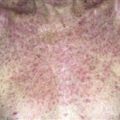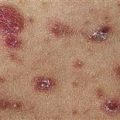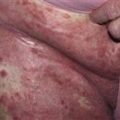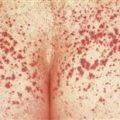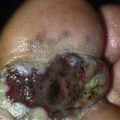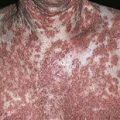48
Folliculitis
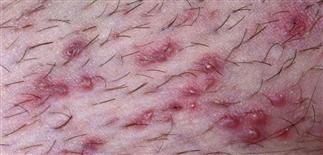
Pustules are typical of folliculitis. They are monomorphic, 1- to 2-mm pustules with a bright halo of erythema. They are classic of staphylococcal folliculitis.
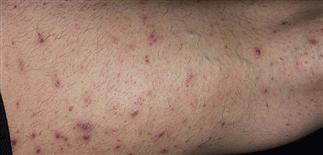
Numerous discreet bright-red papules surrounding hair follicles are seen in this case of folliculitis on the legs. Staphylococcus aureus can be spread by shaving.
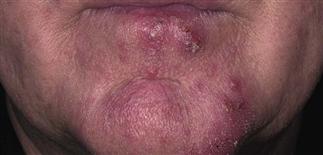
Follicular pustules on the chin may represent bacterial or fungal infection. Consider culture.
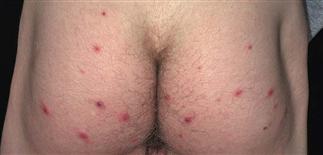
Folliculitis on the buttocks. These lesions are eroded, and the condition is pruritic, and sometimes painful.
DESCRIPTION
Folliculitis means an inflammation of the hair follicle. Common types: mechanical folliculitis from persistent friction or tight clothing, bacterial folliculitis. Bacterial folliculitis includes follicular impetigo, a superficial form, and sycosis barbae, a deep form in beard area. Fungal folliculitis is less common but can result from untreated tinea corporis, or tinea infection in beard or hair-bearing skin.
HISTORY
• Usually, eruption is abrupt. • Bacterial folliculitis can spread by trauma, scratching, or shaving. • Variable distribution; often scalp, arms, legs, axillae, trunk.
PHYSICAL FINDINGS
• Dome-shaped pustules with small erythematous halos arise in the follicle. May be tender. • Staphylococcus aureus is most common infecting organism. • Potassium hydroxide examination of the hair and surrounding scale can exclude dermatophyte infection.
Types
• Staphylococcal folliculitis. Most common form. Pustules, usually without fever or other symptoms. • Dermatophyte folliculitis (tinea of hair follicle). Inflammatory papules and pustules with surrounding scale and eczematous papules. Potassium hydroxide examination of hair and surrounding scale is positive. • Eosinophilic folliculitis. Pruritic, extensive follicular papules on face, neck, chest. Associated with HIV. Diagnosis confirmed or suspected by biopsy. • Gram-negative folliculitis. Acneiform eruption suddenly worsens, becomes pustular. Chronic oral antibiotics predispose. • Hot tub folliculitis. Erythematous papules and pustules primarily on trunk. Pseudomonas from improperly sanitized hot tub. • Mechanical folliculitis. From chronic frictional exposure, such as tight pants, obesity. • Occlusion folliculitis. From occlusion, i.e. exposure to oil, greases, ointments. • Pityrosporum folliculitis. On back and chest. Potassium hydroxide test positive for short hyphae and round spores. • Steroid folliculitis. Multiple monomorphic pustules and red papules within 2 weeks of using systemic corticosteroids.
TREATMENT
• Minimize heat, friction, occlusion. • Frequent change of razor. • Mupirocin (Bactroban) applied three times daily for 5 days for limited involvement. Treat intranasally also if culture confirms carriage of S. aureus. • Oral antistaphylococcal antibiotics (trimethoprim-sulfac, oxacillin, doxycycline, dicloxacillin, cephalexin, cefuroxime) indicated for extensive disease or for deep involvement of sycosis barbae. But culture and sensitivity is important to antibiotic choice, given increasingly methicillin resistant staphylococcus. • Nasal carriage of S. aureus is a common reason for recurrent bacterial folliculitis. Treat the nasal carrier state. • Pityrosporum folliculitis: topical or oral antiyeast antibiotics such as clotrimazole lotion and econazole cream. Two tablets of ketoconazole 200 mg taken once, repeated after 1 week for widespread disease. • Follicular dermatophyte infection (Majocchi granuloma) responds best to oral antifungal therapy.

